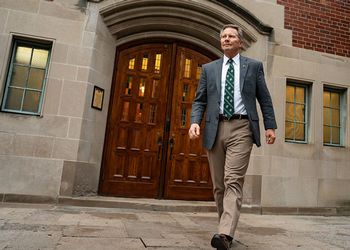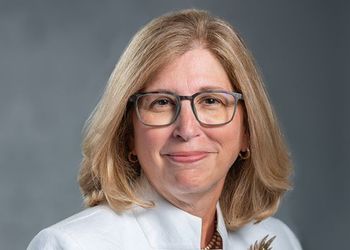Around Circle Drive

THE BOOK ON CAMPUS BEAUTY
A new book confirms what MSU alumni already know--that the university boasts a gorgeous campus. The Campus As a Work of Art (Praeger Publishers ranks MSU among America's 25 most aesthetic campuses and the Circle Drive oval area 'one of the botanical wonders of campusdom.' Author Thomas A Gaines, who is trained in architecture, visited hundreds of campuses during three decades in his search for the most pleasing college environments. He was clearly impressed by MSU's arboretum-like setting. In the book, he quotes the great landscape architect Frederic Law Olmsted describing then Michigan Agricultural College as 'the best example of the type of landscaping characteristic of the 19th century university.' Explains Tom Kehler, director of campus part and planning, 'MSU's heritage since its founding, especially during President Hannah's administration, has emphasized developing the natural elements of the campus.'
FOREST AKERS EARNS GOLF AWARD
MSU's Forest Akers Golf Courses, which just had its west course renovated by America's 'hottest golf architect' has been named a winner of the National Golf Foundation's Public Achievement Award for excellence in promoting public golf. Only one other university-related golf course--the one at Arizona State--won this prestigious honor. The award was based on Akers' educational and promotional programs in areas such as etiquette, speed-of-play and instruction, according to Ken Horvath, manager of the facility and MSU's Men's golf coach. Last June, the MSU Board of Trustees approved the renovation project. Art Hills, an alumnus of MSU and considered among the top golf architects in the country, took charge of the re-design of the 18 holes comprising Forest Akers West. Funding came partly from the Forest Akers Trust.
MSU GOES AFTER SUPER COLLISIONS
MSU is participating in two research projects related to the development of the Superconducting Super Collider. One project will test a fiber-optic apparatus to measure the energy deposits of subatomic particles passing through the SSC. The second project will test the Standard Model of the atomic structure to facilitate the work of high energy physicists. These projects are funded by the Texas National Research Laboratory Commission, which is developing the SSC, the world's largest and most powerful accelerator. When completed in 1999 near Dallas/Fort Worth, the SSC will boast a 54-mile underground facility where protons can collide at near light speed and allow scientists to better understand the fundamental forces and nature of all matter.
MSU'S MED SCHOOL RANKED TOP AGAIN
For the second straight year, MSU's College of Human Medicine was ranked among the top five in the nation for the teaching of primary health care. The rankings were compiled by U.S. News and World Report in their annual cover story special, 'America's Best Graduate Schools.' The magazine looked at the nation's 126 medical schools and ranked them on the basis of many factors, including student selectivity, research activity, faculty resources, and general reputation (as determined by two separate surveys among academics and directors of intern-residency programs). MSU tied with Ohio State for fourth place with an overall score of 95.8 (out of 100). Rounding out the top five comprehensive schools were Thomas Jefferson (1), Brown (2), and Oregon Health Sciences (3). Although MSU officials do not support the kind of methodologies generally used to devise such rankings, the CHM's high choice validates the hard work by many in the college to achieve excellence.
BUILDING NAMED AFTER TROUT
MSU's Food Science Building has been named by the MSU Board of Trustees after the late G. Malcolm Tout Food Science and Human Nutrition Building will memorialize one of the world's most distinguished pioneers in dairy science. Trout, who died in 1990, pioneered in the 1930's the linkage of pasteurization with homogenization in the production of milk. He was a faculty member from 1928 until his retirement in 1966 and won numerous awards, including the College of Agriculture Distinguished Teacher Award (1952 and 1954), MSU's Distinguished Faculty Award (19610 and the American Dairy Science Association's Award of Honor (1964).
LET THE SUN SHINE IN
MSU astronomer Jeffrey Kuhn has earned many kudos. Last summer he succeeded in yet another major achievement when he and a colleague from France were able to take the first infrared color photos ever of the sun. Their shots of the July 11 solar eclipse turned out to be dramatic and were published in Sky and Telescope in December. They were taken at Mauna Kea, Hawaii, utilizing a computerized camera built at MSU. The project, says Kuhn, took a whole year to prepare. 'These are the first infrared shots ever,' says Kuhn. 'Never before have we seen this detail. For example, we can see properties of the dust around the sun we have not seen before. They will help us understand where they came from, how they can exist in the heat, and so on.'
FACULTY KUDOS
Every term, MSU faculty, staff and students garner kudos too numerous to list exhaustively. Here are some representative example:
*Sam M. Austin, distinguished professor of physics and astronomy and director of the National Superconducting Cyclotron Laboratory at MSU, and Mary E. Zabik, distinguished professor of food science and human nutrition and associate dean of the college of Human Ecology, have received 1992 Michigan Association of Governing Boards distinguished faculty awards.
*Joanne Keith, professor of family and child ecology, has received the prestigious 'National Innovative Award in Continuing Education' from the National University Continuing Education Association.
*Roy J. Gerard, a faculty member and retired chairperson of the Dept. of Family Practice, College of Human Medicine, has been named 'Family Practice Educator of the Year' by the Michigan Academy of Family Physicians. Robert H. Burke, assistant professor at the College of Human Medicine and president of the American College of Oral Maxillofacial Surgeons, has been named special guest editor of the American Journal of Cometic Surgery.
MSU TEAM BEATS COMPUTER FOES
MSU student teams have a long tradition of achieving outstanding results in national competitions. The latest to uphold that heritage of excellence is the computer programming team from the College of Engineering. At the International Scholastic Programming Competition last March in Kansas City, MSU finished second in the world by number on among all colleges in the Northern hemisphere, beating teams from schools like Stanford (3rd) and Harvard (6th). 'People act surprised that we beat Harvard and Stanford, ' says Jacob Lorch, a computer science major. 'But we are a great school and we won this award not out of luck but because we deserved it.' The award was worth $5,000 and a laptop computer for MSU, which earned a perfect score in the regional competition prior to the finals. More than 600 three-person teams world-wide originally entered the contest.



